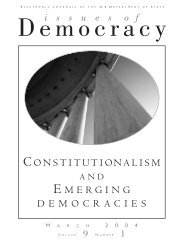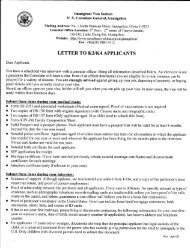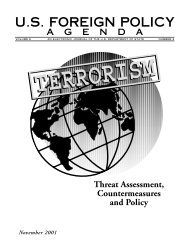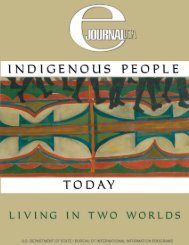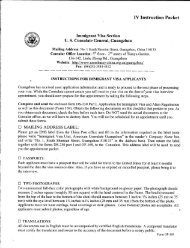s. history us history us history - Embassy of the United States
s. history us history us history - Embassy of the United States
s. history us history us history - Embassy of the United States
- No tags were found...
Create successful ePaper yourself
Turn your PDF publications into a flip-book with our unique Google optimized e-Paper software.
CHAPTER 9: DISCONTENT AND REFORMA NATION OF NATIONSNo country’s <strong>history</strong> has been more closely bound to immigration than that<strong>of</strong> <strong>the</strong> <strong>United</strong> <strong>States</strong>. During <strong>the</strong> first 15 years <strong>of</strong> <strong>the</strong> 20th century alone, over13 million people came to <strong>the</strong> <strong>United</strong> <strong>States</strong>, many passing through Ellis Island,<strong>the</strong> federal immigration center that opened in New York harbor in 1892.(Though no longer in service, Ellis Island reopened in 1992 as a monument to<strong>the</strong> millions who crossed <strong>the</strong> nation’s threshold <strong>the</strong>re.)The first <strong>of</strong>ficial cens<strong>us</strong> in 1790 had numbered Americans at 3,929,214.Approximately half <strong>of</strong> <strong>the</strong> population <strong>of</strong> <strong>the</strong> original 13 states was <strong>of</strong> Englishorigin; <strong>the</strong> rest were Scots-Irish, German, Dutch, French, Swedish, Welsh,and Finnish. These white Europeans were mostly Protestants. A fifth <strong>of</strong> <strong>the</strong>population was enslaved Africans.From early on, Americans viewed immigrants as a necessary resource foran expanding country. As a result, few <strong>of</strong>ficial restrictions were placed uponimmigration into <strong>the</strong> <strong>United</strong> <strong>States</strong> until <strong>the</strong> 1920s. As more and more immigrantsarrived, however, some Americans became fearful that <strong>the</strong>ir culturewas threatened.The Founding Fa<strong>the</strong>rs, especially Thomas Jefferson, had been ambivalentover whe<strong>the</strong>r or not <strong>the</strong> <strong>United</strong> <strong>States</strong> ought to welcome arrivals from everycorner <strong>of</strong> <strong>the</strong> globe. Jefferson wondered whe<strong>the</strong>r democracy could ever restsafely in <strong>the</strong> hands <strong>of</strong> men from countries that revered monarchs or replacedroyalty with mob rule. However, few supported closing <strong>the</strong> gates to newcomersin a country desperate for labor.Immigration lagged in <strong>the</strong> late 18th and early 19th centuries as wars disruptedtrans-Atlantic travel and European governments restricted movementto retain young men <strong>of</strong> military age. Still, as European populations increased,more people on <strong>the</strong> same land constricted <strong>the</strong> size <strong>of</strong> farming lots to a pointwhere families could barely survive. Moreover, cottage ind<strong>us</strong>tries were fallingvictim to an Ind<strong>us</strong>trial Revolution that was mechanizing production. Tho<strong>us</strong>ands<strong>of</strong> artisans unwilling or unable to find jobs in factories were out <strong>of</strong> workin Europe.In <strong>the</strong> mid-1840s millions more made <strong>the</strong>ir way to <strong>the</strong> <strong>United</strong> <strong>States</strong> asa result <strong>of</strong> a potato blight in Ireland and continual revolution in <strong>the</strong> Germanhomelands. Meanwhile, a trickle <strong>of</strong> Chinese immigrants, most from impoverishedSou<strong>the</strong>astern China, began to make <strong>the</strong>ir way to <strong>the</strong> American WestCoast.Almost 19 million people arrived in <strong>the</strong> <strong>United</strong> <strong>States</strong> between 1890 and1921, <strong>the</strong> year Congress first passed severe restrictions. Most <strong>of</strong> <strong>the</strong>se immi-OUTLINE OF U.S. HISTORYgrants were from Italy, R<strong>us</strong>sia, Poland, Greece, and <strong>the</strong> Balkans. Non-Europeanscame, too: east from Japan, south from Canada, and north from Mexico.By <strong>the</strong> early 1920s, an alliance was forged between wage-conscio<strong>us</strong>organized labor and those who called for restricted immigration on racial orreligio<strong>us</strong> grounds, such as <strong>the</strong> Ku Klux Klan and <strong>the</strong> Immigration RestrictionLeague. The Johnson-Reed Immigration Act <strong>of</strong> 1924 permanently curtailed<strong>the</strong> influx <strong>of</strong> newcomers with quotas calculated on nation <strong>of</strong> origin.The Great Depression <strong>of</strong> <strong>the</strong> 1930s dramatically slowed immigration stillfur<strong>the</strong>r. With public opinion generally opposed to immigration, even for persecutedEuropean minorities, relatively few refugees found sanctuary in <strong>the</strong><strong>United</strong> <strong>States</strong> after Adolf Hitler’s ascent to power in 1933.Throughout <strong>the</strong> postwar decades, <strong>the</strong> <strong>United</strong> <strong>States</strong> continued to clingto nationally based quotas. Supporters <strong>of</strong> <strong>the</strong> McCarran-Walter Act <strong>of</strong> 1952argued that quota relaxation might inundate <strong>the</strong> <strong>United</strong> <strong>States</strong> with Marxistsubversives from Eastern Europe.In 1965 Congress replaced national quotas with hemispheric ones. Relatives<strong>of</strong> U.S. citizens received preference, as did immigrants with job skillsin short supply in <strong>the</strong> <strong>United</strong> <strong>States</strong>. In 1978 <strong>the</strong> hemispheric quotas werereplaced by a worldwide ceiling <strong>of</strong> 290,000, a limit reduced to 270,000 afterpassage <strong>of</strong> <strong>the</strong> Refugee Act <strong>of</strong> 1980.Since <strong>the</strong> mid-1970s, <strong>the</strong> <strong>United</strong> <strong>States</strong> has experienced a fresh wave <strong>of</strong>immigration, with arrivals from Asia, Africa, and Latin America transformingcommunities throughout <strong>the</strong> country. Current estimates suggest a total annualarrival <strong>of</strong> approximately 600,000 legal newcomers to <strong>the</strong> <strong>United</strong> <strong>States</strong>.Beca<strong>us</strong>e immigrant and refugee quotas remain well under demand, however,illegal immigration is still a major problem. Mexicans and o<strong>the</strong>r LatinAmericans daily cross <strong>the</strong> Southwestern U.S. borders to find work, higherwages, and improved education and health care for <strong>the</strong>ir families. Likewise,<strong>the</strong>re is a substantial illegal migration from countries like China and o<strong>the</strong>rAsian nations. Estimates vary, but some suggest that as many as 600,000illegals per year arrive in <strong>the</strong> <strong>United</strong> <strong>States</strong>.Large surges <strong>of</strong> immigration have historically created social strains alongwith economic and cultural dividends. Deeply ingrained in most Americans,however, is <strong>the</strong> conviction that <strong>the</strong> Statue <strong>of</strong> Liberty does, indeed, stand as asymbol for <strong>the</strong> <strong>United</strong> <strong>States</strong> as she lifts her lamp before <strong>the</strong> “golden door,”welcoming those “yearning to brea<strong>the</strong> free.” This belief, and <strong>the</strong> sure knowledgethat <strong>the</strong>ir forebears were once immigrants, has kept <strong>the</strong> <strong>United</strong> <strong>States</strong> anation <strong>of</strong> nations.200201



